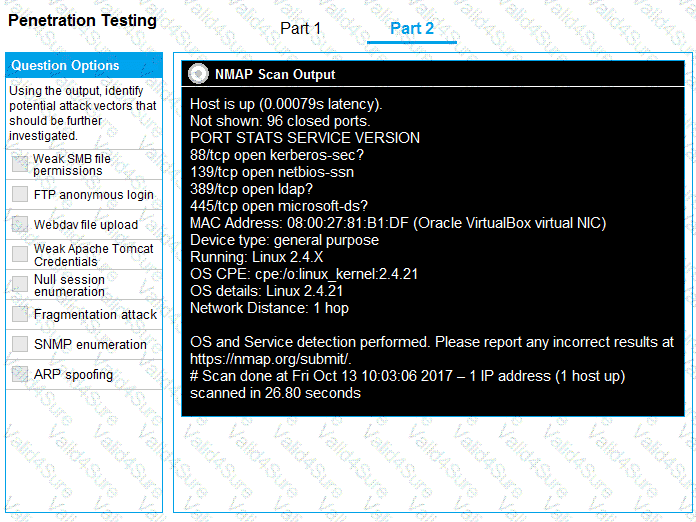PT0-003 Exam Dumps - CompTIA PenTest+ Exam
As part of a security audit, a penetration tester finds an internal application that accepts unexpected user inputs, leading to the execution of arbitrary commands. Which of the following techniques would the penetration tester most likely use to access the sensitive data?
A penetration tester wants to use multiple TTPs to assess the reactions (alerted, blocked, and others) by the client’s current security tools. The threat-modeling team indicates the TTPs in the list might affect their internal systems and servers. Which of the following actions would the tester most likely take?
A penetration tester would like to leverage a CSRF vulnerability to gather sensitive details from an application's end users. Which of the following tools should the tester use for this task?
Given the following statements:
Implement a web application firewall.
Upgrade end-of-life operating systems.
Implement a secure software development life cycle.
In which of the following sections of a penetration test report would the above statements be found?
A penetration tester aims to exploit a vulnerability in a wireless network that lacks proper encryption. The lack of proper encryption allows malicious content to infiltrate the network. Which of the following techniques would most likely achieve the goal?
A penetration tester gains initial access to an endpoint and needs to execute a payload to obtain additional access. Which of the following commands should the penetration tester use?
You are a penetration tester running port scans on a server.
INSTRUCTIONS
Part 1: Given the output, construct the command that was used to generate this output from the available options.
Part 2: Once the command is appropriately constructed, use the given output to identify the potential attack vectors that should be investigated further.
If at any time you would like to bring back the initial state of the simulation, please click the Reset All button.


A penetration tester is performing a cloud-based penetration test against a company. Stakeholders have indicated the priority is to see if the tester can get into privileged systems that are not directly accessible from the internet. Given the following scanner information:
Server-side request forgery (SSRF) vulnerability in test.comptia.org
Reflected cross-site scripting (XSS) vulnerability in test2.comptia.org
Publicly accessible storage system named static_comptia_assets
SSH port 22 open to the internet on test3.comptia.org
Open redirect vulnerability in test4.comptia.org
Which of the following attack paths should the tester prioritize first?